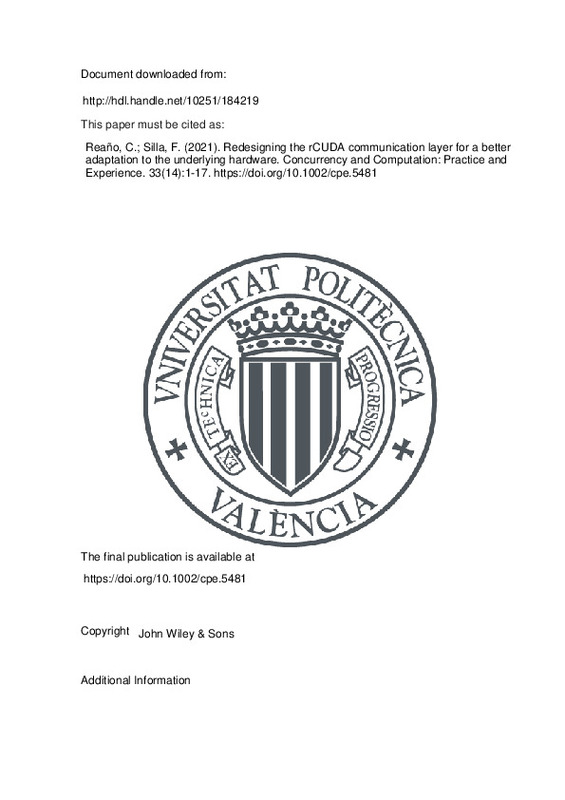JavaScript is disabled for your browser. Some features of this site may not work without it.
Buscar en RiuNet
Listar
Mi cuenta
Estadísticas
Ayuda RiuNet
Admin. UPV
Redesigning the rCUDA communication layer for a better adaptation to the underlying hardware
Mostrar el registro sencillo del ítem
Ficheros en el ítem
| dc.contributor.author | Reaño, Carlos
|
es_ES |
| dc.contributor.author | Silla, Federico
|
es_ES |
| dc.date.accessioned | 2022-07-14T18:04:21Z | |
| dc.date.available | 2022-07-14T18:04:21Z | |
| dc.date.issued | 2021-07-25 | es_ES |
| dc.identifier.issn | 1532-0626 | es_ES |
| dc.identifier.uri | http://hdl.handle.net/10251/184219 | |
| dc.description.abstract | [EN] The use of Graphics Processing Units (GPUs) has become a very popular way to accelerate the execution of many applications. However, GPUs are not exempt from side effects. For instance, GPUs are expensive devices which additionally consume a non-negligible amount of energy even when they are not performing any computation. Furthermore, most applications present low GPU utilization. To address these concerns, the use of GPU virtualization has been proposed. In particular, remote GPU virtualization is a promising technology that allows applications to transparently leverage GPUs installed in any node of the cluster. In this paper, the remote GPU virtualization mechanism is comparatively analyzed across three different generations of GPUs. The first contribution of this study is an analysis about how the performance of the remote GPU virtualization technique is impacted by the underlying hardware. To that end, the Tesla K20, Tesla K40, and Tesla P100 GPUs along with FDR and EDR InfiniBand fabrics are used in the study. The analysis is performed in the context of the rCUDA middleware. It is clearly shown that the GPU virtualization middleware requires a comprehensive design of its communication layer, which should be perfectly adapted to every hardware generation in order to avoid a reduction in performance. This is precisely the second contribution of this work, ie, redesigning the rCUDA communication layer in order to improve the management of the underlying hardware. Results show that it is possible to improve bandwidth up to 29.43%, which translates into up to 4.81% average less execution time in the performance of the analyzed applications. | es_ES |
| dc.description.sponsorship | Generalitat Valenciana, Grant/Award Number: PROMETEO/2017/077 | es_ES |
| dc.language | Inglés | es_ES |
| dc.publisher | John Wiley & Sons | es_ES |
| dc.relation.ispartof | Concurrency and Computation: Practice and Experience | es_ES |
| dc.rights | Reserva de todos los derechos | es_ES |
| dc.subject | CUDA | es_ES |
| dc.subject | GPGPU | es_ES |
| dc.subject | HPC | es_ES |
| dc.subject | InfiniBand | es_ES |
| dc.subject | Virtualization | es_ES |
| dc.subject.classification | ARQUITECTURA Y TECNOLOGIA DE COMPUTADORES | es_ES |
| dc.title | Redesigning the rCUDA communication layer for a better adaptation to the underlying hardware | es_ES |
| dc.type | Artículo | es_ES |
| dc.identifier.doi | 10.1002/cpe.5481 | es_ES |
| dc.relation.projectID | info:eu-repo/grantAgreement/UPV//PROMETEO%2F2017%2F077/ | es_ES |
| dc.rights.accessRights | Abierto | es_ES |
| dc.contributor.affiliation | Universitat Politècnica de València. Departamento de Informática de Sistemas y Computadores - Departament d'Informàtica de Sistemes i Computadors | es_ES |
| dc.description.bibliographicCitation | Reaño, C.; Silla, F. (2021). Redesigning the rCUDA communication layer for a better adaptation to the underlying hardware. Concurrency and Computation: Practice and Experience. 33(14):1-17. https://doi.org/10.1002/cpe.5481 | es_ES |
| dc.description.accrualMethod | S | es_ES |
| dc.relation.publisherversion | https://doi.org/10.1002/cpe.5481 | es_ES |
| dc.description.upvformatpinicio | 1 | es_ES |
| dc.description.upvformatpfin | 17 | es_ES |
| dc.type.version | info:eu-repo/semantics/publishedVersion | es_ES |
| dc.description.volume | 33 | es_ES |
| dc.description.issue | 14 | es_ES |
| dc.relation.pasarela | S\464574 | es_ES |
| dc.contributor.funder | Universitat Politècnica de València | es_ES |







![[Cerrado]](/themes/UPV/images/candado.png)

